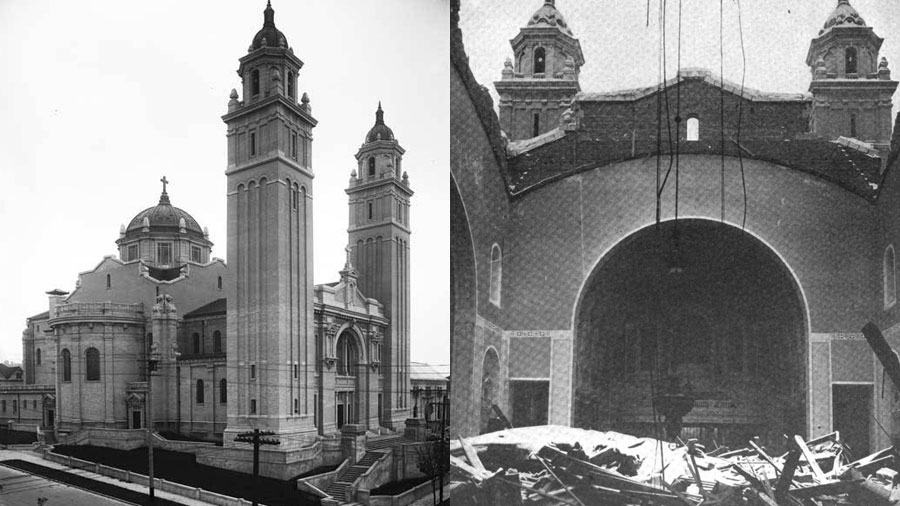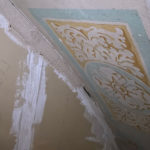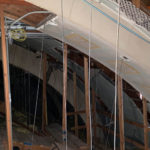How one of Seattle’s first landmarks was nearly destroyed in Big Snow of 1916
Feb 1, 2023, 7:25 AM | Updated: 9:29 am
One of the biggest winter storms to strike the Northwest arrived 106 years ago this week. Though it wasn’t as intense as the Big Snow of 1880, the February 1916 storm nearly destroyed one of Seattle’s earliest landmarks.
February snow is not unheard of in the Northwest – there was February snow in 2021, as well as 2019 for the inauguration of the downtown tunnel – but neither of those events were quite like the Big Snow of 1916. As much as two feet of snow fell in the Puget Sound area that January, and then, another nearly two feet fell between Feb. 1-2.
Sometime during the day on Feb. 2, 1916, the air temperature hovered near 32 degrees. At some point, a mixture of rain and snow began to fall. In those conditions, the snow that has already fallen doesn’t melt away quickly. Instead, that snow can absorb the rain as it falls, and gets very, very heavy.
One of the places where that heavy wet snow really took a toll was at St. James Cathedral on First Hill in Seattle. The cathedral had been completed in time for Christmas 1907, and it was a massive landmark that dominated the skyline in the days before the Smith Tower. When the cathedral debuted, along with its distinctive matching bell towers, it also had a dome. And it was this architectural feature of the cathedral which did not survive the Big Snow of 1916.
In January, KIRO Newsradio was given a special “history tour” and allowed to visit an area where the public is not allowed, high above the pews and altar. The tour guide was Corinna Laughlin, pastoral assistant for liturgy at St. James Cathedral, and resident expert on the landmark’s long history.
“We’re in the attic of St. James Cathedral, and the whole area that you can see with all of these wires and wooden walkways was put in in 1994,” Laughlin said, standing on one of those wooden walkways. “It’s a space between the ceiling of the cathedral and the roof, and it’s a place where you can really get a sense of where the dome was and how it’s been rebuilt over the years.”
The space where Laughlin was standing was created by a major remodeling of the cathedral in the early 1990s, but it also reveals some of the original ceiling that was in place before the dome collapse, and that was covered up as part of the post-collapse repair.
“You can see the simple painting that is supposed to evoke coffering,” Laughlin said, referring to more elaborate ceiling designs that include a pattern of recessed areas. “It’s supposed to look like coffering from the ground, but you can also see how much higher up this is than where the ceiling is now.”
In the original 1907 structure, the dome was about 45 feet in diameter and it topped out at about 110 feet above the ground. It was made from steel beams, and was supported by four horizontal trusses. The dome was mostly solid, but the vertical walls in its lower reaches had windows that allowed in natural light, but it apparently interfered with acoustics in the cathedral – so much so that clear glass was installed at cathedral ceiling level or the base of the dome.
In the photos of St. James Cathedral from before the collapse, the dome there looks not unlike the dome still standing at Holy Names Academy on Capitol Hill, which was built in 1904.
Back in the ceiling at St. James, Laughlin described what happened during the Big Snow of 1916.
“The snow piled up around the base of the dome,” she said. “They say it snowed continuously for something like 27 hours that year, and just the sheer weight of all that wet snow brought the dome crashing to the floor” just after 3 p.m.
“February 2 is a big Feast Day in the church,” Laughlin continued. “It was called ‘The Purification’ back in 1916, now we call it the ‘Presentation of the Lord,’ and it’s traditionally the day for the blessing of candles.”
Laughlin says that the heavy snow that gets the blame for destroying the dome that day also gets the credit for keeping people out of harm’s way.
“Fortunately, Seattle shut down in 1916, just like it does now when it snows,” Laughlin said. “Nobody was in the cathedral so nobody was injured, but the cathedral suffered serious damage, because the collapse of the dome took a lot of the ceiling with it. Basically, the building had to be closed for more than a year and essentially rebuilt.”
As to why it happened, the snow was suspected immediately, but there were at least a few other contributing factors.
Jeff Berman is a professor in civil engineering at the University of Washington. He says that steel manufacturing hadn’t been perfected yet in 1907, and quality control hadn’t quite made wide-scale consistent production of industrial-grade steel possible. Some of the articles in old newspapers and engineering journals published not long after the collapse single out a failed steel truss that was found in the rubble.
Some of the reportage also points to possible disconnects between the New York blueprints from the famous architectural firm of Heins & LaFarge who designed St. James, and the local construction crews who were tasked with building something more complex than just about any other structure within hundreds of miles of Seattle.
But, Professor Berman says, the main culprit definitely was all that snow.
“They actually weighed the snow after the collapse and concluded that it was very heavy snow because it was saturated with rain, which makes a lot of sense,” Berman said. “If you’re a skier, you know this quite well, right? ‘Cascade concrete.’”
Berman says there’s actually a term used to describe the condition of snow that’s been made heavier by absorbing rain – it’s called the “rain on snow surcharge” – and jurisdictions in areas where snow and rain conditions are common adapt their local building codes to take this surcharge into account.
Snow-related collapses were not uncommon in the early 20th century; just last week, the Washington, D.C., area marked the centennial of a 1922 collapse of the Knickerbocker Theatre, a tragedy which killed nearly 100 people.
But the amount of the 1916 snowfall was unusual for the Seattle area, and since it was a less sophisticated era, building codes didn’t yet take these extreme weather event possibilities into account. Estimates in those old engineering journals say the snow on the roof around the dome weighed somewhere between 28 pounds to 35 pounds per cubic foot – for a total estimated additional load of 30 tons.
Nobody witnessed the late afternoon collapse, but those old newspaper accounts say it made quite a sound when the dome – and all that soggy snow – let loose on the cathedral space below. KIRO Newsradio’s Dave Ross, who emceed a 2016 centennial commemoration of the dome collapse, says the event included a simulation of the sound, courtesy of the cathedral’s two pipe organs.
Back in 1916, Bishop O’Dea began planning to replace the dome, and drawings were released that summer that included a new dome that was taller and wider than the original. Ultimately, there wasn’t much enthusiasm and the decision was made to just build a roof where the dome once stood. The repaired cathedral reopened in March 1917, slightly more than a year after the dome collapse. However, when the building underwent a major renovation in 1990s, a skylight – or “oculus” — was added where the dome once stood.
Father Michael Ryan is the pastor of St. James Cathedral. Following Laughlin’s tour, he shared a story about his 1916 predecessor, Monsignor William Noonan.
Pastor Noonan had a certain sensitivity to the perception of St. James Cathedral and the Catholic community by other Seattleites, Father Ryan says, and in the immediate aftermath of the collapse, Monsignor Noonan apparently tried to control the “messaging.”
“I think he must have been aware that when St. James was built, some of the people in the city would have thought it was an overreach,” Father Ryan said. “There weren’t many Catholics here, they built this largest church in the city, and crowning the hill with it, and then eight years later, it collapses on itself.
“So his first thought was, ‘How is this going to play out in the public?,’” Father Ryan continued. “And it’s well attested he had the editor of the Catholic newspaper next to him, Bill O’Connell, and he said, ‘William, not a word to the press.’”
How did that work out?
“And of course, Seattle had three dailies in those days, the P-I, the Times, and the Star, and it was the front page of every one of them.”
Editor’s Note: This story was originally published Feb. 2, 2022
You can hear Feliks every Wednesday and Friday morning on Seattle’s Morning News, read more from him here, and subscribe to The Resident Historian Podcast here. If you have a story idea, please email Feliks here.






















